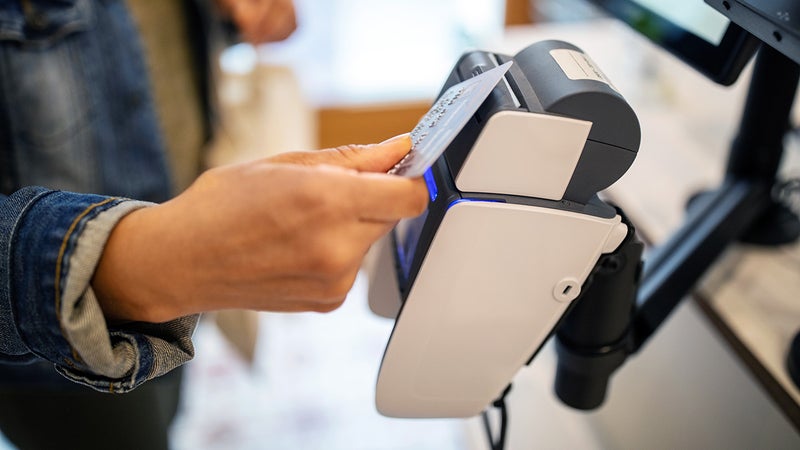What is a secured credit card and how does it work?

The Bankrate promise
At Bankrate we strive to help you make smarter financial decisions. While we adhere to strict , this post may contain references to products from our partners. Here's an explanation for . The content on this page is accurate as of the posting date; however, some of the offers mentioned may have expired. Terms apply to the offers listed on this page. Any opinions, analyses, reviews or recommendations expressed in this article are those of the author’s alone, and have not been reviewed, approved or otherwise endorsed by any card issuer.
When your FICO credit score is in the lowest range — 579 or below — finding a credit card issuer who will approve you for one of its products can seem like an impossible feat. Fortunately, card issuers offer one type of credit card that almost anyone can be approved for.
With a secured credit card, consumers with poor credit get the chance to build credit, practice good credit card habits and prove their creditworthiness over time. This form of credit requires a cash deposit to secure a line of credit. However, despite having to pay a deposit, secured credit cards can function like traditional credit cards.
What is a secured credit card?
Getting approved for an unsecured credit card can be very difficult when your credit score is poor, yet you may not be able to improve your credit over time if you can’t find a lender to give you a line of revolving credit. It seems counterintuitive when you can’t build credit without a credit card, but you can’t get approved for a credit card without having an established credit score. That is where secured credit cards come in.
A secured credit card is a type of credit card that is backed by a cash deposit. The deposit is often equal to the credit limit, which tends to be equal to 50 percent to 100 percent of the amount of the initial deposit. If you apply for a secured credit card and put down a $1,000 deposit as collateral, for example, you’ll likely qualify for a $500 to $1,000 line of credit as a result.
How do secured credit cards work?
A secured credit card functions similarly to a debit card. However, you’re essentially relying on your cash deposit, which is what translates to your secured line of credit to make purchases.
To get a secured credit card, you can apply for one at a bank, credit union or credit card company. The financial institution you’re working with may check your credit history during the approval process.
The credit card provider should report information about your account to the three main credit bureaus — Experian, Equifax and TransUnion — which helps build your credit score. You’ll want to double-check with the issuing company before you apply to make sure it will report your payment history to the three main credit bureaus.
If approved, you’ll need to make a deposit that acts as collateral. This is often at least $200 and can be as high as $2,000 to $3,000. In some cases, your deposit amount will act as your credit limit, although your limit may also be less than the deposit amount. After making the initial deposit, you can use the card to make purchases in-person or online up to your credit limit amount. A secured credit card can be used in places where credit cards are accepted like gas stations or grocery stores.
Once you pay off your balance for any recent purchases, you can then use the card again to make more purchases. If you don’t pay off your balance in full each month, you will start to incur interest on the carried balance.
Secured vs. unsecured credit cards
Generally speaking, unsecured credit cards are more appealing to most consumers. When a card is unsecured, you don’t have to put down a deposit as collateral. Unsecured credit cards also tend to come with better perks and rewards, lower fees and lower interest rates. However, there are only a few unsecured credit cards available for bad credit.
When you start out with a secured credit card and you prove your creditworthiness by making consistent, on-time payments, your credit card issuer may automatically upgrade you to an unsecured credit card. It should be noted that changing from secured to unsecured credit cards might take around 12 to 18 months. It all depends on how well you manage your payments and build your credit score. When it comes to building your credit score, you’ll use the same process with a secured credit card as you would with an unsecured credit card.
The following chart explains some of the biggest differences between secured and unsecured credit cards:
| Card details | Unsecured credit cards | Secured credit cards |
|---|---|---|
| Minimum credit score to qualify | Usually 670+ | Available for scores below 579 |
| Deposit required? | No | Yes |
| Average APR | Around 20% (as of July 2023) | Often over 20% |
| Annual fee charged? | Sometimes | Usually |
| Helps you build credit by reporting to credit bureaus | Yes | Usually |
| Rewards available? | Usually yes | Usually no |
Secured credit cards vs. prepaid debit cards
It is important not to confuse a secured credit card with a prepaid debit card. One of the differences is that prepaid cards do not generate credit scores. If that’s what you are looking for, a prepaid debit card is not a great option.
With secured credit cards, you borrow and pay later. In contrast, prepaid debit cards require you to deposit before spending. Why do you need to deposit before spending with a prepaid debit card? The reason is that prepaid debit cards are not linked to your bank account.
Many can get confused since secured credit cards require a deposit. But the credit card company provides funding that you pay back each month in order to positively build your credit score.
The following chart explains some of the biggest differences between secured credit cards and prepaid debit cards:
| Card details | Prepaid debit cards | Secured credit cards |
|---|---|---|
| Minimum credit score to qualify | N/A | Available for scores below 579 |
| Deposit required? | Yes (before spending) | Yes |
| Average APR | N/A | Often over 20% |
| Annual fee charged? | Variable | Usually |
| Helps you build credit by reporting to credit bureaus | No | Usually |
| Rewards available? | Depends on the issuer | Usually no |
When should you get a secured credit card?
Consumers often use secured credit cards as a way to build their credit scores either because of a rocky financial past or simply because they have no credit history. Whichever situation you may relate to the most, let’s take a further look at when it may be the right time to consider a secured credit card.
You want to build your credit
Secured credit cards provide cardholders with a small line of credit in exchange for a refundable deposit that is put down as collateral. If you have poor credit or no credit at all, lenders see you as a liability because you have no credit history to prove what kind of borrower you are. However, by putting down a security deposit, the lender takes on some protection in the case that you default on your payments.
However, like any credit card, building credit is all about how you use the credit you have access to in the first place. If you can manage to keep your credit utilization low and make on-time payments every month, your credit score will improve in no time.
You want to graduate to an unsecured credit card
Secured credit cards make it easy to graduate to an unsecured credit card once you’ve successfully worked on your credit score.
Your issuer may upgrade you to an unsecured credit card once you prove your creditworthiness with on-time payments, or you can ask your credit card issuer to transfer your secured line of credit to an unsecured credit card.
Alternatively, you could apply for a new unsecured credit card while holding on to the secured credit card account. Closing a credit card can actually hurt your credit score because you are reducing the total amount of credit you have access to in the first place. However, keep in mind when you close your secured credit card account, that is typically when you’ll get your full deposit back.
Tips for using a secured credit card
When it comes to using unsecured credit cards, the same rules apply to secured credit cards. Here are a few recommendations to keep your score in the best shape possible:
- Always pay your balance on time. On-time payments are the single most important factor when it comes to calculating your credit score, accounting for 35 percent of your overall score. You want to aim to pay your statement balance in full every month to avoid interest and keep your credit in good standing. If you can’t make the full payment, don’t fret, but always make at least the minimum payment on time.
- Confirm that the bank reports to the three main bureaus. If you are using a secured credit card in order to improve your credit score, you’ll want to ensure the credit card provider is reporting your credit usage to the three main credit bureaus. Some issuers may not report the status of secured cards, so make sure you are applying for a secured card that reports to at least one of the credit bureaus if better credit is your goal.
- Keep your credit utilization rate below 30 percent. Credit utilization refers to the total amount of available credit you’re currently using in relation to the total amount of credit you have access to. Generally, it is best to keep your credit utilization below 30 percent. A high credit utilization means you’re close to maxing out your credit card and this can ultimately hurt your credit score.
- Don’t overspend. The key to using a secured credit card is to use it for a few fixed purchases each month so it is harder to reach your credit limit. This will help you learn financial discipline while also building a strong credit score. When you are searching for a secured credit card, try to avoid committing to a deposit that will get you in financial trouble. Just because you have access to a $1,000 credit limit, doesn’t mean you should max out your card the minute you get it.
The bottom line
Secured credit cards may be the way to go if you’ve never had a credit card or want to improve your credit score. Building credit with a secured credit card is a great way to get your finances on track by establishing strong financial habits. This requires a bit of discipline as you learn the do’s and don’ts of credit, but when you put in the work, you will be on track to upgrading to an unsecured credit card in no time.






